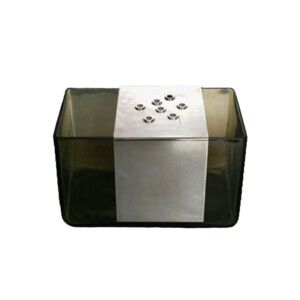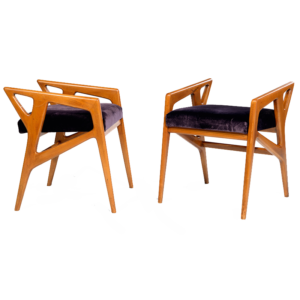(1891-1979)
Literature: Italian Design: 1870 to the Present. Penny Sparke; Gio Ponti, by Ugo La Pietra
Gio Ponti was one of the great design geniuses of the 20th century. The scope and variety of his genius can been seen in architecture, glass, furniture, textiles, costume and theater design, lighting, and home and industrial design. Giovanni Ponti was born in 1891 in Milan, Italy. He grew up in Milan, and studied architecture at the Politecnico di Milano. Although Ponti had to interrupt his studies to serve in the Italian army during World War I (he was an ardent supporter of Mussolini), he graduated from the Politecnico in 1921 with a degree in architecture.
After two years as a practicing architect with Emilio Lancia and Mino Fiocchi, Ponti decided to explore other areas. In 1923, he became the artistic director of ceramics manufacture for Richard-Ginori, and, during this time, produced many iconic pieces, such as the highly desirable and rare “Architecture” vases, and whimsical pieces such as hands with a variety of lyrical decorations, and bowls and vases with stylized figures. He often used gold for the figures on his pieces. By taking simple ceramic forms, and decorating them with a variety of neo-classical motifs, Ponti transformed the company, giving it a strong reputation for excellent and original design. Ponti won the Grand Prix at the 1925 Paris Expo forthe pieces he produced as artistic director of Ginori.
Although Ponti remained as artistic director for Ginori until 1930, he had not lost his passion for architecture, 
In 1928, Ponti started Domus, an architecture and design magazine that would allow him to express his ideas regarding the artistic movement, Novecento, and also to show-case the best of Italian design. Ponti is famous for having been a major part of the Novecento, a counter-movement to Rationalismo. Followers of Novecento were interested in creating art that expressed the ideas of Fascism. Their goal was to revive the traditional and classical art of Italy, and reject the European Avant Garde Movement. This is interesting, as Ponti’s zeal for Fasciam is not really apparent in his work, and so much of what he did, although grounded in Italian tradition, was innovative, highly original, and has provided material for others to copy, and his influence can still be seen in contemporary design. Domus became one of the most influential magazines in Europe. From 1941 to 1947, Ponti left Domus to found a new magazine called Stile. In his absence, the direction of the magazine had changed to advocate rationalist ideas. Upon his return, Ponti redirected Domus, and used it as a venue to display his favorite designers.
While Ponti remained a spokesperson for the Novecento movement, and created work that reinforced the ideas of this movement, he also participated in projects that helped to integrate crafts with industrial productions. During the 1930s, Ponti designed lighting and furniture for Fontana, and eventually became a joint director of the Fontana subsidiary Fontana Arte. He curated the Triennale in Milan, and was awarded larger architectural commissions, such as the Mathematics Department at Rome University in 1934, and the headquarters of Montecatini, in 1936. His furniture of this period was luxurious in the use of materials, and full of sensuous curves and whimsical touches.
Ponti continued to expand his areas of interest. By the late 1940s, Ponti had begun a three year project to design Murano glass for his friend, Paolo Venini, head of the highly important glass manufacturer, and was also designing stage sets and costumes for La Scala, in Milan. Ponti worked in collaboration with Nino Zoncade to restore four Italian liners, and also created one of his most famous and iconic pieces, the La Pavoni coffee machine, which symbolized the post-war coffee bar culture of Italy, and is still in use today. He also worked with Paolo Di Poli, the famed enamel artist, on a series of elegant yet humorous decorative objects. Fruits, animals, birds, fish, and many other subjects were reduced to three dimensional forms with simple and elegant lines that could be made from one piece of copper, and than decorated with Di Poli’s beautiful enamels. Several pieces of furniture were also designed with enameled elements by Paolo Di Poli.
Throughout the 1950s, Ponti became even more occupied with industrial design, emphasizing pieces that could be inexpensively mass – produced. He designed the angular Distex armchair in 1953, and the Superleggera chair in 1957. The Superleggera chair was designed for Cassina, and was inspired by traditional chairs that Ponti had seen at the seaside. This chair was extremely strong, but light enough to be lifted with one finger. It soon became a classic work of this period. He also continued to design more luxurious and very distinctive furniture, with surfaces covered in various trompe l’oeil surfaces.
In 1955, Ponti built Villa Planchart, often referred to as the “Butterfly House.” Hovering over the city of Caracas, Villa Planchart is decorated with soft colors, lively patterns, and illuminations. One year after Villa Planchart was constructed, Ponti created perhaps the most famous and important work of his career – the Pirelli Tower. Located 
During the 1960s and 1970s, Ponti continued to work, most notably building the San Francesco Church in Milan, the San Carlo Chapel in Milan, the Denver Art Museum, as well as the Taranto Cathedral.
Gio Ponti died in 1979, in his home, on Via Nezza in Milan. His pieces remain in high demand today by collectors and others interested in the some of the best design of the 20th century.
Showing all 2 results
-
$0.00



